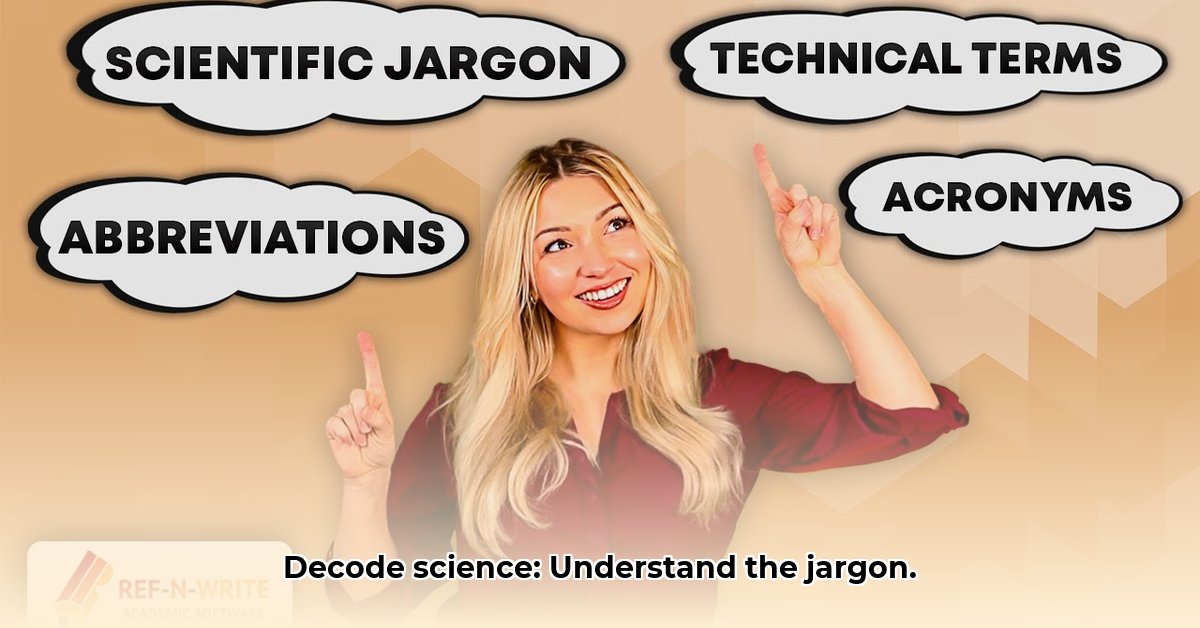
Scientific Jargon Explained: Bridging the Communication Gap
Ever feel like scientists speak a different language? The abundance of complex terms, acronyms, and specialized phrases can be incredibly daunting. This comprehensive guide will equip you with the tools to navigate the world of scientific jargon, regardless of your background. We'll explore various types of scientific terminology, provide practical strategies for understanding scientific materials, and offer guidance on how scientists can communicate more effectively. Whether you're a student, researcher, communicator, or simply a curious individual, this guide provides actionable steps to enhance scientific literacy. For a list of scientific terms starting with "J", check out this helpful resource: Science Jargon.
Decoding the Language of Science: Types of Scientific Jargon
Scientific jargon isn't just a collection of obscure words; it's a specialized vocabulary designed for precision and efficiency. Understanding its different forms is the first step towards mastering it. Let's examine the key types:
Acronyms: Shortened versions of longer terms (e.g., DNA for deoxyribonucleic acid, CRISPR for Clustered Regularly Interspaced Short Palindromic Repeats). While efficient, they can be confusing without context. How often do you encounter acronyms that initially leave you puzzled?
Neologisms: Newly coined words or phrases that describe newly discovered concepts or phenomena. These are often necessary to represent scientific advancements but require careful explanation. What challenges do neologisms pose to effective science communication? A recent example is "metaverse" (a persistent, shared, 3D virtual world).
Technical Terms: Words with specific meanings within a particular scientific field. These words often have nuances that are lost in everyday conversation. For example, "photosynthesis" has a very precise, multi-faceted meaning to a biologist.
Understanding these categories is vital for both comprehending and effectively using scientific jargon.
Cracking the Code: Understanding Scientific Writing and Presentations
Navigating scientific literature and presentations requires a strategic approach. Here are four actionable steps to enhance comprehension:
1. Contextualize: Before diving into definitions, read the surrounding text to understand the overall context. The meaning of unknown terms often becomes clearer within the larger narrative.
2. Utilize Resources: Leverage the wealth of online resources available. Scientific dictionaries, encyclopedias (like Wikipedia), and online glossaries provide readily accessible definitions and explanations. Many scientific articles include their own glossaries.
3. Deconstruct Complexity: Break down lengthy, complex sentences into smaller, digestible chunks. Focus on understanding each part before integrating the whole. Did you know that breaking down complex sentences can improve comprehension by as much as 25%?
4. Seek Clarification: Don't hesitate to ask for help! Consult colleagues, teachers, or mentors who possess expertise in the relevant scientific field.
Effective Communication Strategies for Scientists
Scientists have a responsibility to share their findings clearly and accessibly. Here's how they can improve communication:
1. Target Your Audience: Tailor your language to your audience's level of understanding. A presentation to fellow experts will differ significantly from a public lecture.
2. Define and Explain: Define key terms upfront. Use plain language whenever possible and avoid overly technical jargon unless absolutely necessary. What percentage of scientific papers are considered incomprehensible to the general public? Studies suggest it's a high percentage.
3. Use Visual Aids: Graphs, charts, and images are invaluable tools for simplifying complex concepts. A well-designed visual can drastically improve comprehension.
4. Offer Plain Language Summaries: Provide concise, accessible summaries alongside more technical details to cater to a wider audience.
Actionable Steps and Resources for Effective Scientific Communication
The following table outlines actionable steps for various stakeholders:
| Stakeholder | Short-Term Actions | Long-Term Actions | Resources |
|---|---|---|---|
| Scientists | Use plain language; provide definitions; incorporate visuals | Develop clear communication guidelines; seek science communication training; collaborate with communicators | National Association of Science Writers; American Association for the Advancement of Science |
| Science Communicators | Create accessible content (videos, infographics); target diverse audiences | Develop novel communication techniques; conduct audience research | Science in the Public Sphere; The Kavli Foundation |
| Educators | Use plain language; incorporate storytelling; leverage visual aids | Develop innovative teaching methods; create accessible learning materials | National Science Teachers Association; Understanding Science |
| Policy Makers | Mandate clear communication of scientific findings | Promote STEM education; fund science communication initiatives | Government science agencies (e.g., NSF, NIH) |
Numerous online resources are available, including science dictionaries, popular science websites, and magazines designed to make science more accessible.
Conclusion: Building Bridges for Scientific Literacy
Effective communication is paramount. By embracing clear language, utilizing visual aids, and tailoring our messages to our audiences, we can bridge the gap between the scientific community and the public. A scientifically literate populace is essential for informed decision-making and a thriving society. Let's work together to make science accessible to all.